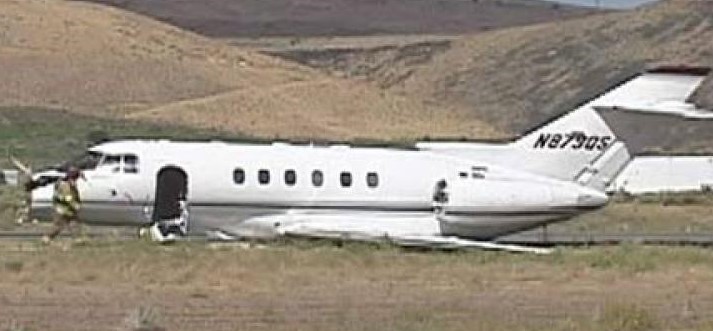Planned Land
 Tuesday, June 16, 2020 at 7:43PM
Tuesday, June 16, 2020 at 7:43PM On August 28, 2006, at 1506 Pacific daylight time, a Raytheon Aircraft Company Hawker 800XP business jet N879QS, and a Schleicher ASW27-18 glider collided in midair about 10 miles west-northwest of Smith, Nevada. Both airplanes sustained substantial damage.
Before the collision, the flight crew were cleared by ATC from 16,000 feet to 11,000 feet. The captain was the flying pilot and the first officer was working the radios. ATC transferred the flight to Reno approach control just prior to the collision and as the first officer tuned in the Reno approach control radio frequency he looked out the right cockpit window. He then heard the captain shout and the autopilot disconnect and noted that the captain had pushed the control yoke down and to the right. As he was turning his head to see what was going on, he observed the captain's side of the instrument panel "explode." The Hawker sustained significant impact damage to its nose section. A section of the glider's wing spar remained imbedded in the nose structure, with the captain's side sustaining the most damage. The pressure bulkhead had been compromised by the impact. The captain's instrument panel was destroyed with the primary instrumentation being indiscernible. Examination of control continuity after the accident, with the glider spar in place, revealed that the elevator controls could not be pushed forward of a neutral position. The right wing sustained leading edge damage that compromised the fuel tank. The left horizontal stabilizer's leading edge exhibited a large hole that extended aft to the mounting flange.

The first officer and captain reported that the cockpit was noisy with wind after the collision, and the captain's headset had been knocked off. The first officer attempted to communicate with Reno ATC but had difficulty. The captain recovered the airplane as the first officer communicated to Reno ATC that they had some sort of structural problem. As the flight progressed north, they spotted an airport (Carson City) and elected to land. As the flight neared the airport, the flight crew noted that the right engine had shut down as a result of the impact. The flight crew entered the traffic pattern but the landing gear would not extend normally and there was difficulty in controlling the speed, so the aircraft was positioned for another approach. While the aircraft was in the traffic pattern at Carson City, the first officer informed the passengers that they were going to make a gear-up landing and everyone was to secure their seatbelts.
The airplane touched down on the runway centreline, with the landing gear retracted, and came to rest uneventfully.

The belly of the fuselage and inboard wings sustained scrape marks from landing with the gear retracted. The left engine fan blades displayed nicks and cracks, and the lower cowling drain mass was broken. The right engine inlet area also sustained significant impact damage leaving a large void into the cowling. The fan blades were cracked and broken. The tail pipe had fiberglass embedded in the duct and fuel was dripping from the lower cowling and fuel control unit.
The Hawker flight crew sustained minor injuries, while their three passengers were not injured. The glider pilot received minor injuries.
The NTSB report is here